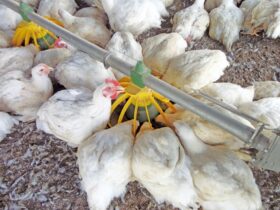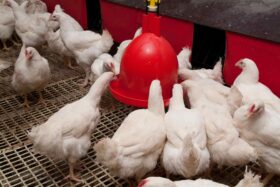Author: Sabria Regragui Mazili, Science Communication Team, EW Nutrition
As people across the globe are re-discovering home cooking, grocery items such as milk, flour, and eggs are in higher demand than ever. Legendary chef Michel Roux once said that “Eggs are more than an element of cooking… The little egg is life.” Let us look at the complex system that allows us to enjoy this superfood – and how egg producers tackle the supply chain disruptions caused by the pandemic.

The coronavirus pandemic has led to increased demand for eggs and, therefore, to temporary shortages
Eggs: from farm to table
The story of our breakfast eggs starts with another set of eggs. The hens and cocks on so-called parent stock or layer breeder farms produce fertilized eggs (1). These “hatching eggs” are transferred to specialized hatcheries where the chicks hatch after 21 days (2). The female chicks, who will go on to become the hens that lay our eggs, are sent to so-called rearing or pullet farms, where they grow up (3). The young hens are then transferred to the layer farms (4).
When they are about 20 weeks old, the hens start to lay – and join the 7 billion chickens that produce more than 1.3 trillion eggs for us every year. During their 14-month laying period, hens will lay 360+ eggs.
Newly laid eggs need to be collected, and checked for quality (grading). About 50-65% of the hens’ output can be sold as “shell eggs,” i.e. whole eggs, to outlets servicing the hospitality industry and end consumers (5). These eggs need to be stamped and then packaged in the egg cartons we all know. “Breaker eggs,” i.e. irregularly sized or broken eggs, do not go to waste: they are moved to processing plants that produce liquid egg and egg powder products for food industry clients such as industrial bakeries and ice cream manufacturers (6).
How many steps it ultimately takes to get eggs from the farm to your plate depends on the complexity of the marketing channel. Farms might do their branding on-site; others work with specialized companies for packaging and branding. Some farms have direct relationships with retailers; others sell to wholesale outlets and distributors. The logistics for getting eggs quickly and safely from A to B involve dedicated egg distribution centers and fleets of refrigerated trucks.
Did you know?
An egg’s color depends on the layer hen’s breed. In the beginning, all eggs are white; those that end up being brown (or, in the case of certain chicken breeds, green or blue) have pigments deposited on them as the eggs pass through the hen’s oviduct.
The reason brown eggs are usually more expensive than white ones is that brown egg layer breeds tend to be heavier and consumer more feed. The eggshell color does not influence the egg’s taste or nutritional value.
Infographic: The egg supply chain, from farm to table
Coronavirus and food: disruptive effects on supply
The impact of the COVID-19 pandemic is felt along each step of this complex process. Disruptions in the supply chain for feed ingredients that mostly come from China, such as amino acids and vitamins, has led to increased price volatility of these ingredients, affecting farmers’ production costs.
Labor availability is a significant concern, for example with respect to the numerous transitions between locations. According to a recent Rabobank report on the situation in Europe, even though food transportation services are exempted from lockdown measures, the high incidence of COVID-19 cases are contributing to driver shortages and higher transport costs. Importantly, everyone working on the “front line” of food supply chains – drivers, as well as farmers, processors, distributors, or retail employees – are doing so at considerable personal risk.
… and effects on demand
Despite these disruptions, animal producers are under pressure to increase production as food consumption patterns are changing in light of COVID-19. In Argentina, for example, the national egg producers association just reported that household consumption of eggs rose by 40% since the country went into lockdown on March 20.
In the US, egg orders from some retailers have increased by up to six times their normal levels, according to market research firm Urner Barry, while wholesale egg prices have risen 180% throughout March. Yet, hens can’t lay more than they already do; to increase flocks takes time and significant investment in additional facilities.
To ease egg supply shortages, the US Food and Drug Administration has temporarily relaxed certain packaging and labeling requirements for shell eggs sold in retail markets. In Canada, egg supplies usually destined for restaurants are being re-directed to meet increased consumer demand.
Egg producers are finding solutions
This would not work in Germany, where, according to egg and poultry analyst Margit Beck, many of the eggs used in the ailing foodservice sector are cage eggs*, for which there is little end consumer demand. Cage egg prices are effectively in free fall, while crisis-induced consumer reflections on purchasing behaviors appear to strengthen demand for free-range and organic eggs. Smaller farmers in Germany and Austria report that they capitalize on this trend through increased direct sales to customers at farm shops and markets.
The sight of (temporarily) empty supermarket shelves might be disconcerting – but, positively, it ought to inspire us to appreciate the incredible work that goes into putting eggs on our tables. Clapping for health care workers has become a new tradition during this pandemic. It would only be fitting to also give a hand for the numerous people along food supply chains whose commitment keeps us all going.
* Note: Conventional battery cages have been banned in Germany since 2010; eggs classified as cage eggs come from laying hens kept in small-group housing systems or in so-called “enriched cages”.
















